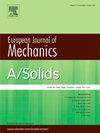A graded elastic modulus concept to eliminate stress or strain energy density singularity at sharp notches and cracks, with consequent elimination of size-scale effect on strength
IF 4.4
2区 工程技术
Q1 MECHANICS
引用次数: 0
Abstract
It has been recently suggested by the author that in the classical problem of a sharp wedge or crack loaded in plane (mode I and/or mode II), the stress singularity can be removed by grading the elastic properties of the underlying material from the notch tip by using a power law, . While the treatment is extended to the case of mode III (antiplane shear) which permits closed form results, we also discuss two ways to deal with the likely effect of material’s grading on strength. In one, already explored in the previous paper, the strength is a power law of the modulus, and we suggest an “optimal” design by keeping the dominant stress constantly equal to the strength. In a second method, we propose to cancel the singularity in the strain energy density, which requires a much stronger grading, and we also possibly take into account that the critical strain energy density is a power law of the modulus. Noticing that only in the presence of a singularity a length scale can be defined experimentally by testing a very large notch and a very small one, according to the Theory of Critical Distances (TCD), the effect of cancelling singularity also implies independence on size/scale and constant strength. It is concluded that the technique is much more powerful than drilling a hole or rounding the tip of the notch/crack. Moreover, if a “smart” material could be designed to damage itself as to reduce its modulus when near a high stress concentration according to our prescriptions, it would naturally self-heal, opening up interesting applications.
分级弹性模量概念可消除尖锐缺口和裂缝处的应力或应变能量密度奇异性,从而消除尺寸尺度对强度的影响
作者最近提出,在平面加载(模式 I 和/或模式 II)的尖锐楔形或裂缝的经典问题中,可以通过使用幂律 E∼rβ 对缺口顶端的底层材料的弹性特性进行分级来消除应力奇异性。虽然处理方法扩展到了模式 III(反平面剪切)的情况,从而可以得到封闭形式的结果,但我们也讨论了处理材料分级对强度可能产生的影响的两种方法。其中一种方法已在前一篇论文中探讨过,即强度是模量的幂律,我们建议采用一种 "最优 "设计,使主要应力始终等于强度。在第二种方法中,我们建议消除应变能密度中的奇异点,这需要更强的分级,我们还可能考虑到临界应变能密度是模量的幂律。根据临界距离理论(TCD),只有在存在奇异点的情况下,才能通过测试一个非常大的凹口和一个非常小的凹口来实验定义长度尺度,因此取消奇异点的效果也意味着尺寸/尺度的独立性和强度的恒定性。结论是,该技术比钻孔或将缺口/裂缝顶端修圆要强大得多。此外,如果一种 "智能 "材料能根据我们的规定,在接近高应力集中时自我损坏以降低模量,那么它自然会自我修复,从而开辟出有趣的应用领域。
本文章由计算机程序翻译,如有差异,请以英文原文为准。
求助全文
约1分钟内获得全文
求助全文
来源期刊
CiteScore
7.00
自引率
7.30%
发文量
275
审稿时长
48 days
期刊介绍:
The European Journal of Mechanics endash; A/Solids continues to publish articles in English in all areas of Solid Mechanics from the physical and mathematical basis to materials engineering, technological applications and methods of modern computational mechanics, both pure and applied research.

 求助内容:
求助内容: 应助结果提醒方式:
应助结果提醒方式:


